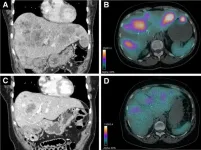(Press-News.org) Imagine your healthy child gets sick—so sick that you take them to the emergency department. You are shocked to find out that their liver is failing, and they will need a transplant to survive. Studies show that their chances of survival are higher the faster they can get to a hospital that performs liver transplants. But what factors affect how quickly that happens?
Pediatric acute liver failure, also called PALF, is a life-threatening condition that emerges with very little warning in previously healthy children. It is rare, affecting about 5,000 children in the United States a year, and can result from viral hepatitis or drug-induced liver injury (such as a child accidentally swallowing too much Tylenol)—or appear with no apparent cause at all. Many children recover with supportive care or medications, but for some, an emergency liver transplant is the only way to save their lives.
A Children’s Hospital Los Angeles research team found that, for these children, the likelihood of receiving a liver transplant and the prospects of recovery can depend upon factors outside of their overall health.
“Studies have shown that prompt referral to a liver transplant center reduces the chances of death,” says Johanna Ascher Bartlett, MD, Transplant Hepatology fellow at CHLA and corresponding author on the paper. “But is everybody who needs a transplant referred to a transplant center in time? Outside of the clinical factors we are monitoring, we wanted to understand if there were any overlooked disparities that we could address to improve our patients’ ability to receive transplants and care.”
The researchers wanted to know if patient race, ethnicity and social determinants of health—the environmental factors like neighborhood, social support systems, economic stability and more that can affect a person’s health in unexpected ways—could impact the outcomes of children with acute liver failure. The researchers examined the medical records of 145 children admitted to CHLA with acute liver failure over the past two decades. The team then validated the CHLA results with data from 156 patients who were part of the larger National Institutes of Health Pediatric Acute Liver Failure Study Group, which included patients from 12 different centers.
The analysis, published in January 2024 in the journal Pediatric Transplantation, showed that factors like family support, employment (parent or caretaker), patient age, race and language spoken can affect clinical outcomes. “Families with more financial and interpersonal support tend to experience better outcomes—spontaneous recovery or liver transplant rather than death—while patients from lower-income families have worse outcomes, regardless of insurance status,” says Dr. Ascher Bartlett. “Overall, our data indicate that the children who died more often had limited social support systems and parents who were the primary caregiver but who worked full-time.”
Uncovering hidden influences
In the Children’s Hospital Los Angeles group:
55% of CHLA liver transplant patients reported having “extensive” community and family/friend support
40% of families of patients who died reported having extensive support
11% of primary caregivers were unemployed in the group of transplant patients with worse outcomes
7% of transplant patients who died had primary caregivers who were unemployed
5% of patients in the spontaneous recovery group had primary caregivers who were unemployed
“These data show that barriers still exist for children with acute liver failure who are admitted to pediatric transplant centers,” says Juliet Emamaullee, MD, PhD, FRCSC, FACS, transplant surgeon at CHLA and senior author on the paper. “There may be unconscious biases held by medical teams in evaluating children with acute liver failure. Our data serves as a reminder that we need to maintain a patient-centered approach when evaluating patients, especially for families that may struggle to navigate the complexities of the health care system.”
Overcoming disparities
However, when the researchers examined CHLA acute liver failure patients for disparities using the social deprivation index—a standard statistical tool measuring income, poverty rate and education according to zip code—they found that socio-economic disparities existed, but did not necessarily interfere with these children’s chances of getting a transplant or their health outcomes.
“While similar studies on a larger scale and in different urban settings are needed to truly determine the relationships between social determinants of health and access to prompt care at a transplant center, our data suggests that current referral patterns to CHLA—the only freestanding pediatric hospital in the U.S. that serves under-resourced communities—may be effective in overcoming these potential barriers,” says Dr. Emamaullee, Research Director, Division of Abdominal Organ Transplantation. “From our experience, screening for inequities can equip clinicians with the tools needed to identify unmet health-related social and economic needs of patients, and collaborating with community health organizations could allow providers to refer patients with socioeconomic insecurities so they can be more quickly routed to transplant centers.”
END
Children's Hospital Los Angeles researchers uncover social and economic factors that influence acute liver failure in children—and ways to overcome them
CHLA study identifies socioeconomic factors that can impact the health outcomes of patients with pediatric acute liver failure (PALF)
2024-02-13
ELSE PRESS RELEASES FROM THIS DATE:
Uncovering insights about prostate cancer risk and genetic ancestry
2024-02-13
This study included larger groups of people from African, Hispanic and Asian ancestries than many other previous studies.
A recent study involving scientists from the U.S. Department of Energy’s (DOE) Argonne National Laboratory has uncovered insights into the prostate cancer risks of people from a variety of genetic ancestries. The project, which was led by the University of Southern California, included large increases in representation among men of African, Hispanic and Asian ancestries, that were contributed in part by an ongoing collaboration between the U.S. Department of Veterans Affairs (VA) and DOE as ...
A century of reforestation helped keep the eastern US cool
2024-02-13
American Geophysical Union
13 February 2024
AGU Release No. 24-5
For Immediate Release
This press release and accompanying multimedia are available online at: https://news.agu.org/press-release/a-century-of-reforestation-helped-keep-the-eastern-us-cool/
A century of reforestation helped keep the eastern US cool
Much of the U.S. warmed during the 20th century, but the eastern part of the country remained mysteriously cool. The recovery of forests could explain why
AGU press contact:
Liza Lester, +1 (202) 777-7494, news@agu.org (UTC-5 hours)
Contact information for the researchers:
Kim ...
IL-17 promotes IL-18 production in osteoarthritis synovial fibroblasts via…
2024-02-13
“This study provides novel insights into the pathogenesis of OA and suggests a potential therapeutic target in OA treatment.”
BUFFALO, NY- February 13, 2024 – A new research paper was published in Aging (listed by MEDLINE/PubMed as "Aging (Albany NY)" and "Aging-US" by Web of Science) Volume 16, Issue 2, entitled, “IL-17 promotes IL-18 production via the MEK/ERK/miR-4492 axis in osteoarthritis synovial fibroblasts.”
The concept of osteoarthritis (OA) as a low-grade inflammatory ...
New data speed record on optical fiber
2024-02-13
As data traffic continues to increase, there is a critical need for miniaturized optical transmitters and receivers that operate with high-order multi-level modulation formats and faster data transmission rates. In an important step toward fulfilling this requirement, researchers developed a new compact indium phosphide (InP)-based coherent driver modulator (CDM) and showed that it can achieve a record high baud rate and transmission capacity per wavelength compared to other CDMs. CDMs are optical transmitters used in optical communication systems that can put information on light by modulating the amplitude and phase before it is transmitted through optical fiber.
“Services that require ...
UBCO researchers get to the bottom of non-invasive gut tests
2024-02-13
New research from UBC Okanagan could make monitoring gut health easier and less painful by tapping into a common—yet often overlooked—source of information: the mucus in our digestive system that eventually becomes part of fecal matter.
Correct, what’s in our poop.
Researcher Dr. Kirk Bergstrom and post-graduate student Noah Fancy of UBCO's Biology department discovered a non-invasive technique to study MUC2, a critical gut protein, from what we leave behind in the bathroom.
“MUC2 is like the silent star in our guts. It’s constantly working ...
Radiopharmaceutical therapy controls symptoms and reduces medications in insulinoma patients
2024-02-13
Reston, VA—Peptide receptor radionuclide therapy (PRRT) is effective for clinical control of symptomatic metastatic insulinomas, according to new research published in the February issue of The Journal of Nuclear Medicine. In the largest study to date of metastatic insulinoma patients treated with PRRT, more than 80 percent of patients had long-lasting symptom control, and nearly 60 percent were able to reduce the use of other drugs to treat the disease.
Metastatic insulinoma is a rare malignant neuroendocrine tumor characterized ...
First-of-its-kind ACC registry tracks cardiac procedures performed in ambulatory surgical settings
2024-02-13
The American College of Cardiology’s newest registry offers data-driven insights on cardiac procedures performed in the ambulatory surgery setting through its first-of-its-kind dashboard. The number of cardiac procedures being performed in ambulatory surgery centers has grown significantly in the last decade, leading ACC’s NCDR to create the CV ASC Registry Suite to fit into the established workflow and allow these facilities to measure and compare their patient care and outcomes to similar procedures performed in the hospital outpatient setting.
Ambulatory surgery centers (ASCs) are health care facilities that provide same-day surgical care, ...
Business operations affect fishermen's resilience to climate change, new study finds
2024-02-13
Timothy Frawley has spent the better of the past two decades working in and around commercial fisheries. Born and raised in Casco Bay, Maine, he grew up packing lobsters and pitching bait on Portland’s working waterfront. He has worked in commercial fisheries in California, Alaska and the Mexican state of Baja California Sur.
Throughout his years spent on working waterfronts, Frawley, a postdoctoral researcher affiliated with the University of Maine’s Darling Marine Center, closely observed the ways in which fishermen conducted their business, making decisions about what and how they fished, and how it affected their operations and profit.
“While ...
Not too late to repair: gene therapy improves advanced heart failure in animal model
2024-02-13
Heart failure remains the leading cause of mortality in the U.S. During a heart attack blood stops flowing into the heart. Without oxygen, part of the heart muscle dies. The heart muscle does not regenerate, instead it replaces dead tissue with a scar made of cells called fibroblasts that do not help the heart pump. If there is too much scarring, the heart progressively enlarges, or dilates, weakens and eventually stops working.
“The current thought is that advanced or chronic heart failure, a stage in which the cardiac muscle has become too weak, is a point of no return. The present ...
Seeking a middle ground for reducing greenhouse emissions
2024-02-13
As the world gradually transitions to making meaningful reductions in greenhouse gas emissions, one of the most crucial questions that needs to be answered is how much that change is going to cost.
The United Nations Intergovernmental Panel on Climate Change (IPCC) has put out reports on this potential cost that showed global greenhouse gas emissions can be reduced by at least half in 2030 at a cost of less than $100 per ton of CO2 equivalent. A new study from the University of Delaware, Yale University and Columbia University, however, points out that these estimates do not consider some hidden, underlying frictions ...
LAST 30 PRESS RELEASES:
Injectable breast ‘implant’ offers alternative to traditional surgeries
Neuroscientists devise formulas to measure multilingualism
New prostate cancer trial seeks to reduce toxicity without sacrificing efficacy
Geometry shapes life
A CRISPR screen reveals many previously unrecognized genes required for brain development and a new neurodevelopmental disorder
Hot flush treatment has anti-breast cancer activity, study finds
Securing AI systems against growing cybersecurity threats
Longest observation of an active solar region
Why nail-biting, procrastination and other self-sabotaging behaviors are rooted in survival instincts
Regional variations in mechanical properties of porcine leptomeninges
Artificial empathy in therapy and healthcare: advancements in interpersonal interaction technologies
Why some brains switch gears more efficiently than others
UVA’s Jundong Li wins ICDM’S 2025 Tao Li Award for data mining, machine learning
UVA’s low-power, high-performance computer power player Mircea Stan earns National Academy of Inventors fellowship
Not playing by the rules: USU researcher explores filamentous algae dynamics in rivers
Do our body clocks influence our risk of dementia?
Anthropologists offer new evidence of bipedalism in long-debated fossil discovery
Safer receipt paper from wood
Dosage-sensitive genes suggest no whole-genome duplications in ancestral angiosperm
First ancient human herpesvirus genomes document their deep history with humans
Why Some Bacteria Survive Antibiotics and How to Stop Them - New study reveals that bacteria can survive antibiotic treatment through two fundamentally different “shutdown modes”
UCLA study links scar healing to dangerous placenta condition
CHANGE-seq-BE finds off-target changes in the genome from base editors
The Journal of Nuclear Medicine Ahead-of-Print Tip Sheet: January 2, 2026
Delayed or absent first dose of measles, mumps, and rubella vaccination
Trends in US preterm birth rates by household income and race and ethnicity
Study identifies potential biomarker linked to progression and brain inflammation in multiple sclerosis
Many mothers in Norway do not show up for postnatal check-ups
Researchers want to find out why quick clay is so unstable
Superradiant spins show teamwork at the quantum scale
[Press-News.org] Children's Hospital Los Angeles researchers uncover social and economic factors that influence acute liver failure in children—and ways to overcome themCHLA study identifies socioeconomic factors that can impact the health outcomes of patients with pediatric acute liver failure (PALF)






